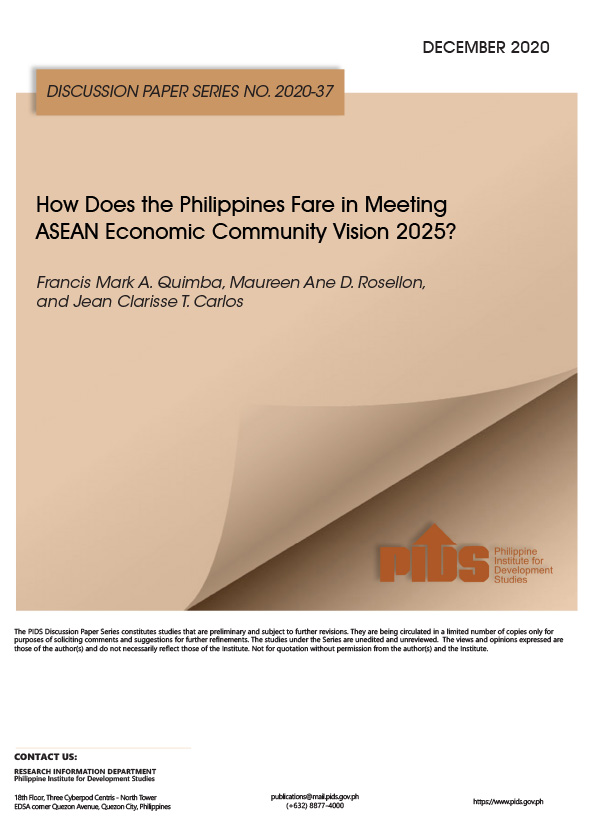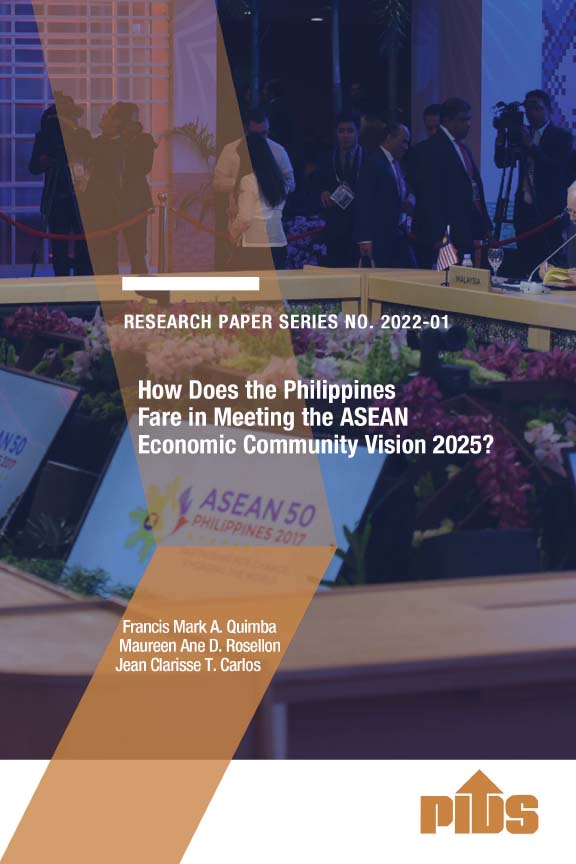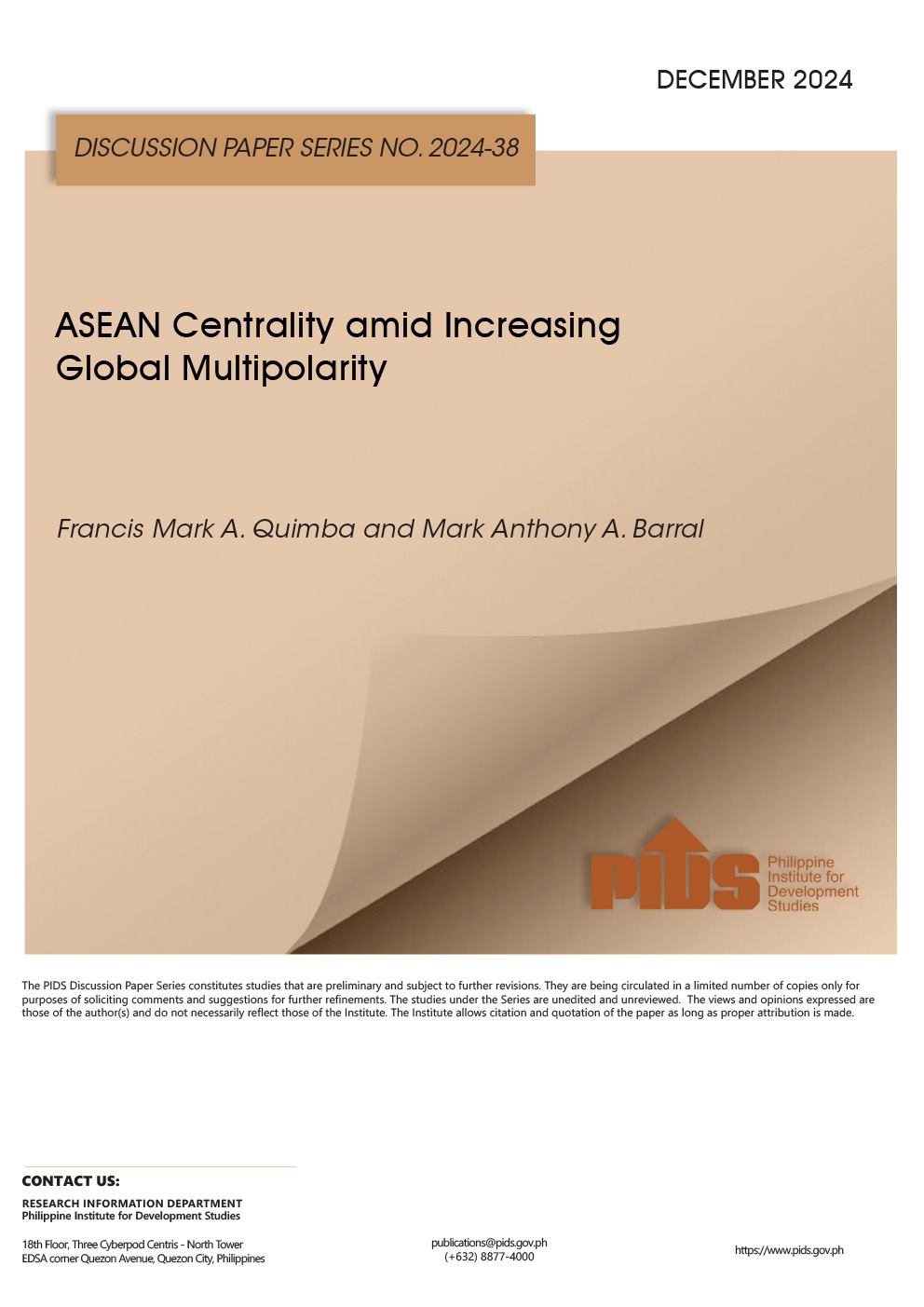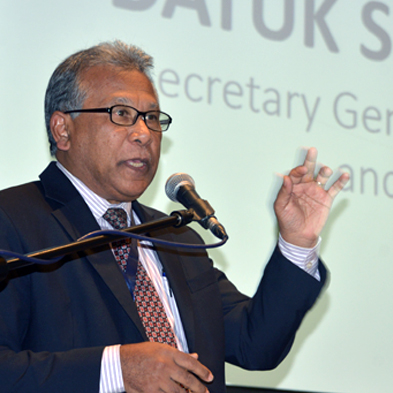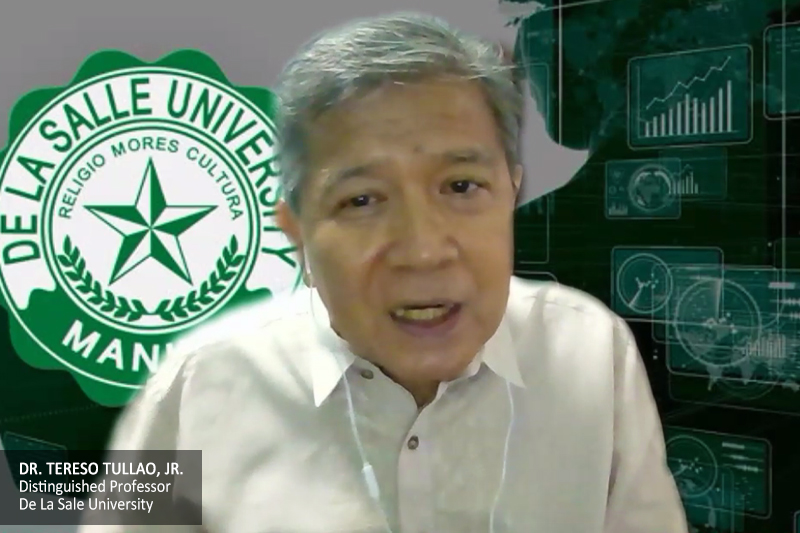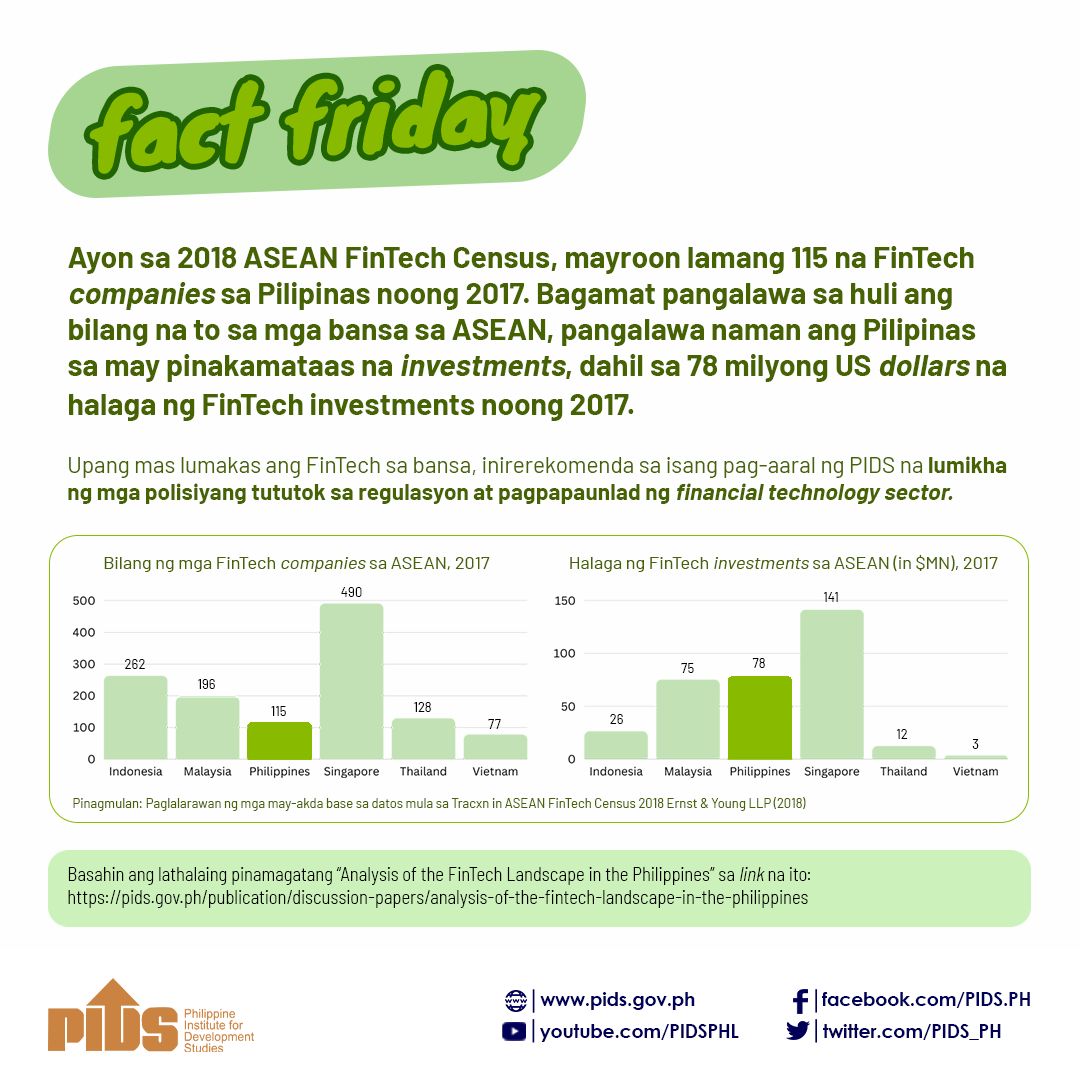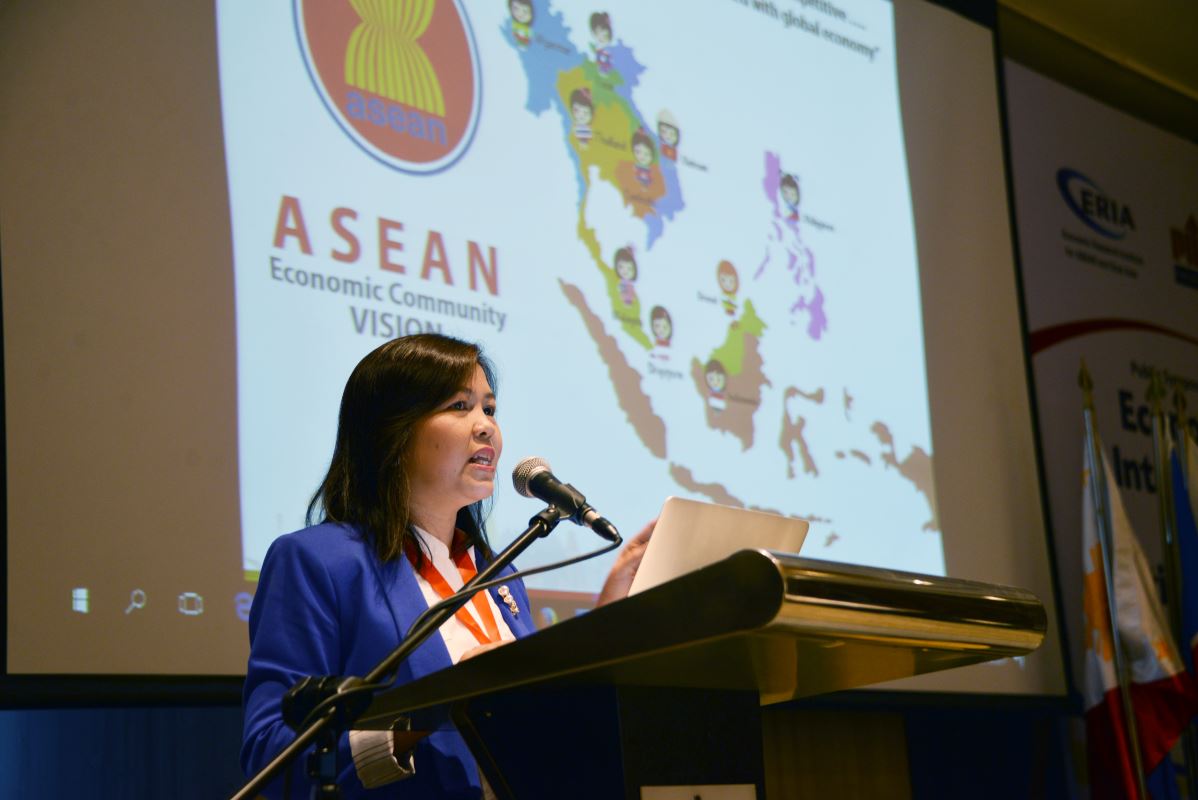
The Association of Southeast Asian Nations (ASEAN) has significantly helped its member-states achieved economic progress, a Vietnamese senior economic official said.
At the Public Symposium on Economic Integration and Nation Building held in Manila recently, Dr. Vo Tri Thanh, former vice president and a senior expert of the Central Institute for Economic Management of Viet Nam, praised ASEAN for pushing its member-states to aim for sustainability, inclusiveness, and innovation.
The symposium is one of the commemorative outreach activities organized by state think tank Philippine Institute for Development Studies (PIDS) and Jakarta-based Economic Research Institute for ASEAN and East Asia (ERIA) to celebrate ASEAN’s 50th anniversary this year. It aims to enhance the engagement of stakeholders of ASEAN on economic issues to promote a better understanding of the ASEAN economic integration.
‘Meaningful playing field’
According to Vo, the regional bloc has served as a “meaningful playing field” for Southeast Asian countries to explore their comparative advantages, participate in the global market, and advance domestic reforms.
“In the case of Viet Nam, for instance, ASEAN has allowed us to see the best performers in the region, like Singapore, Thailand, and Malaysia, and align our economic targets based on their performance,” Vo explained.
He likewise revealed that this year alone, Viet Nam expects 20,000 new private enterprises through the intervention of ASEAN.
Viet Nam became part of the ASEAN in 1995, prior its membership to other regional organizations, such as the Asia-Pacific Economic Cooperation in 1998 and World Trade Organization in 2007.
“That time, we did not have deep understanding of the relevance of international integration, economic integration, free trade arrangement,” Vo said. Viet Nam, however, later on realized the need for a good neighbor to advance peace and stability.
“Before, when we look at Thailand or the Philippines, we thought they were not our friends but our enemies as they were enjoying the support of the US army to fight against Viet Nam. Now, we have a region with, more or less, peace and stability, which is the foundation of everything,” he explained.
ASEAN urged to retreat from protectionism
In the case of the Philippines, PIDS President Gilberto Llanto said the ASEAN has helped the country advance economic reforms and liberalism, especially among small and medium enterprises (SMEs).
“SMEs are crucial because they are at the core of our respective economies in terms of share of total establishments and share of total employment, and even in terms of share of gross domestic product,” according to Llanto.
A 2014 ERIA report revealed that ASEAN SMEs accounted for at least 95 percent of all registered businesses in the region, except in Myanmar, where they made up more than 88 percent of the enterprises. In the Philippines alone, 99.6 percent of all registered enterprises were SMEs in 2014.
As such, the Philippine Development Plan tagged SMEs as the country’s vehicle for inclusive growth.
Llanto likewise encouraged member-states not to retreat to protectionism, and instead appreciate SMEs as good vehicle for economic integration within the ASEAN. He highlighted the ASEAN Strategic Action Plan for SME Development 2016-2025, which aims to enhance the competitiveness and flexibility of SMEs in moving toward a single market and production base in ASEAN.
“There should be a convergence, a catch-up, and one way to catch up would be to promote SMEs,” he explained.
However, Llanto revealed that ASEAN SMEs continue to suffer from several issues that hamper their growth, such as lack of access to relevant technologies and information, limited marketing skills and management capacity, high business costs, inability to comply to standards, and limited attention to innovation. He explained these are also the reasons behind the inability of the SMEs to participate in the global value chain.
Llanto urged the member-states to improve the regulatory environment in the region, as well as to harmonize the rules and to push for the translation of ASEAN-wide plans to national policies.
“There is also a need to review and even revoke regulations which constrict investment flows and increased cost of doing business,” Llanto explained, citing the guillotine project in Viet Nam, which chops down regulations unnecessary and constrain businesses and investments.
BIMP-EAGA as a ‘building block’ for ASEAN
Meanwhile, Dr. Janet Lopoz, executive director of the Mindanao Development Authority, urged ASEAN to maximize the potentials of the Brunei Darussalam-Indonesia-Malaysia-Philippines East ASEAN Growth Area (BIMP-EAGA) as a building block toward achieving ASEAN economic integration.
BIMP-EAGA is one of the subregional cooperation initiatives currently found within Southeast Asia, along with the Indonesia-Malaysia-Thailand Growth Triangle and the Greater Mekong Subregion. According to the Mindanao official, the said subregion hosts a big number of SMEs and is positioning itself to become the agribusiness and food hub of ASEAN.
In the Philippines, BIMP-EAGA’s focus area is Mindanao, which supplies more than half of the country’s food requirement.
Lopoz urged the ASEAN to appreciate BIMP-EAGA as a practical test bed for economic integration given its countries’ proximity to one another, cultural affinity, and historical trade practices.
She added this will likewise ensure that the benefits of ASEAN integration will be inclusive and will accrue not only to the big players but also for the focus areas of the BIMP-EAGA, which are considered the least developed in their respective countries.
Lopoz explained BIMP-EAGA is currently setting up food production zones in different regional corridors, such as in Mindanao, Sabah, Sarawak, and Sulawesi, Indonesia. These production zones will later on be linked through the EAGA inter-modal transport linkages to lower the cost of production.
“We have to start the connectivity within the subregional groupings within the ASEAN and interlink it to the rest of ASEAN, which is more practical,” Lopoz added.
Such establishment of connectivity within the subregional groupings already started with the Davao-General Santos-Bitung, Indonesia roll on/roll off shipping service, which served as one of the flagship ASEAN connectivity projects within BIMP-EAGA.
“In the past, products in Mindanao will have to go up to Manila to go to Jakarta to the areas of the market. By paving this direct connection with our neighbor within BIMP-EAGA, it cuts the cost of transport of our producers and our traders by as much as 67 percent depending on the commodity,” Lopoz explained.
“Imagine the cost saved because of the integration and connectivity within the subregion,” she added.
This, according to Lopoz, addresses one of the critical development constraints that limit SMEs’ participation in the global value chain, which is the inadequacy of the infrastructure and logistics in ASEAN.
Aside from the facilitation and connectivity, the public symposium also covered issues on liberalization and good governance, ASEAN and East Asia integration, as well as the roles of the Regional Comprehensive Economic Partnership. ###
At the Public Symposium on Economic Integration and Nation Building held in Manila recently, Dr. Vo Tri Thanh, former vice president and a senior expert of the Central Institute for Economic Management of Viet Nam, praised ASEAN for pushing its member-states to aim for sustainability, inclusiveness, and innovation.
The symposium is one of the commemorative outreach activities organized by state think tank Philippine Institute for Development Studies (PIDS) and Jakarta-based Economic Research Institute for ASEAN and East Asia (ERIA) to celebrate ASEAN’s 50th anniversary this year. It aims to enhance the engagement of stakeholders of ASEAN on economic issues to promote a better understanding of the ASEAN economic integration.
‘Meaningful playing field’
According to Vo, the regional bloc has served as a “meaningful playing field” for Southeast Asian countries to explore their comparative advantages, participate in the global market, and advance domestic reforms.
“In the case of Viet Nam, for instance, ASEAN has allowed us to see the best performers in the region, like Singapore, Thailand, and Malaysia, and align our economic targets based on their performance,” Vo explained.
He likewise revealed that this year alone, Viet Nam expects 20,000 new private enterprises through the intervention of ASEAN.
Viet Nam became part of the ASEAN in 1995, prior its membership to other regional organizations, such as the Asia-Pacific Economic Cooperation in 1998 and World Trade Organization in 2007.
“That time, we did not have deep understanding of the relevance of international integration, economic integration, free trade arrangement,” Vo said. Viet Nam, however, later on realized the need for a good neighbor to advance peace and stability.
“Before, when we look at Thailand or the Philippines, we thought they were not our friends but our enemies as they were enjoying the support of the US army to fight against Viet Nam. Now, we have a region with, more or less, peace and stability, which is the foundation of everything,” he explained.
ASEAN urged to retreat from protectionism
In the case of the Philippines, PIDS President Gilberto Llanto said the ASEAN has helped the country advance economic reforms and liberalism, especially among small and medium enterprises (SMEs).
“SMEs are crucial because they are at the core of our respective economies in terms of share of total establishments and share of total employment, and even in terms of share of gross domestic product,” according to Llanto.
A 2014 ERIA report revealed that ASEAN SMEs accounted for at least 95 percent of all registered businesses in the region, except in Myanmar, where they made up more than 88 percent of the enterprises. In the Philippines alone, 99.6 percent of all registered enterprises were SMEs in 2014.
As such, the Philippine Development Plan tagged SMEs as the country’s vehicle for inclusive growth.
Llanto likewise encouraged member-states not to retreat to protectionism, and instead appreciate SMEs as good vehicle for economic integration within the ASEAN. He highlighted the ASEAN Strategic Action Plan for SME Development 2016-2025, which aims to enhance the competitiveness and flexibility of SMEs in moving toward a single market and production base in ASEAN.
“There should be a convergence, a catch-up, and one way to catch up would be to promote SMEs,” he explained.
However, Llanto revealed that ASEAN SMEs continue to suffer from several issues that hamper their growth, such as lack of access to relevant technologies and information, limited marketing skills and management capacity, high business costs, inability to comply to standards, and limited attention to innovation. He explained these are also the reasons behind the inability of the SMEs to participate in the global value chain.
Llanto urged the member-states to improve the regulatory environment in the region, as well as to harmonize the rules and to push for the translation of ASEAN-wide plans to national policies.
“There is also a need to review and even revoke regulations which constrict investment flows and increased cost of doing business,” Llanto explained, citing the guillotine project in Viet Nam, which chops down regulations unnecessary and constrain businesses and investments.
BIMP-EAGA as a ‘building block’ for ASEAN
Meanwhile, Dr. Janet Lopoz, executive director of the Mindanao Development Authority, urged ASEAN to maximize the potentials of the Brunei Darussalam-Indonesia-Malaysia-Philippines East ASEAN Growth Area (BIMP-EAGA) as a building block toward achieving ASEAN economic integration.
BIMP-EAGA is one of the subregional cooperation initiatives currently found within Southeast Asia, along with the Indonesia-Malaysia-Thailand Growth Triangle and the Greater Mekong Subregion. According to the Mindanao official, the said subregion hosts a big number of SMEs and is positioning itself to become the agribusiness and food hub of ASEAN.
In the Philippines, BIMP-EAGA’s focus area is Mindanao, which supplies more than half of the country’s food requirement.
Lopoz urged the ASEAN to appreciate BIMP-EAGA as a practical test bed for economic integration given its countries’ proximity to one another, cultural affinity, and historical trade practices.
She added this will likewise ensure that the benefits of ASEAN integration will be inclusive and will accrue not only to the big players but also for the focus areas of the BIMP-EAGA, which are considered the least developed in their respective countries.
Lopoz explained BIMP-EAGA is currently setting up food production zones in different regional corridors, such as in Mindanao, Sabah, Sarawak, and Sulawesi, Indonesia. These production zones will later on be linked through the EAGA inter-modal transport linkages to lower the cost of production.
“We have to start the connectivity within the subregional groupings within the ASEAN and interlink it to the rest of ASEAN, which is more practical,” Lopoz added.
Such establishment of connectivity within the subregional groupings already started with the Davao-General Santos-Bitung, Indonesia roll on/roll off shipping service, which served as one of the flagship ASEAN connectivity projects within BIMP-EAGA.
“In the past, products in Mindanao will have to go up to Manila to go to Jakarta to the areas of the market. By paving this direct connection with our neighbor within BIMP-EAGA, it cuts the cost of transport of our producers and our traders by as much as 67 percent depending on the commodity,” Lopoz explained.
“Imagine the cost saved because of the integration and connectivity within the subregion,” she added.
This, according to Lopoz, addresses one of the critical development constraints that limit SMEs’ participation in the global value chain, which is the inadequacy of the infrastructure and logistics in ASEAN.
Aside from the facilitation and connectivity, the public symposium also covered issues on liberalization and good governance, ASEAN and East Asia integration, as well as the roles of the Regional Comprehensive Economic Partnership. ###

